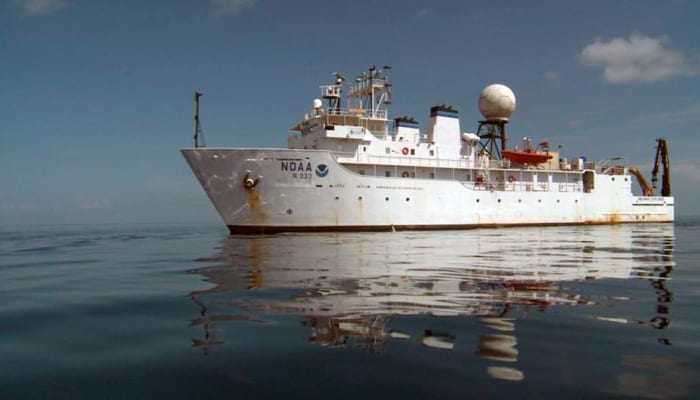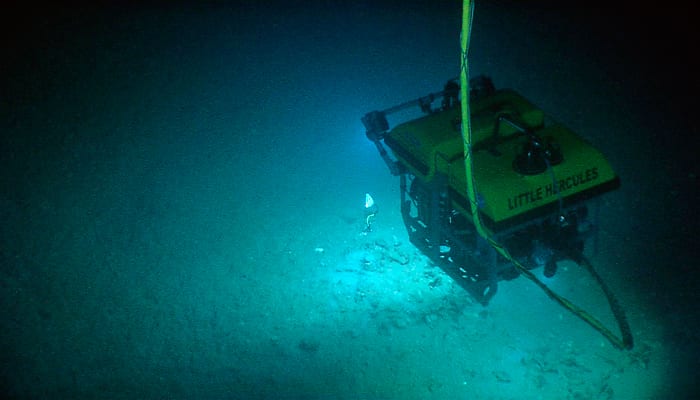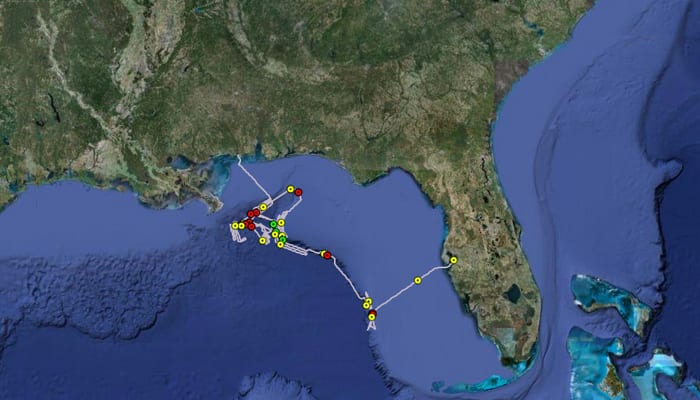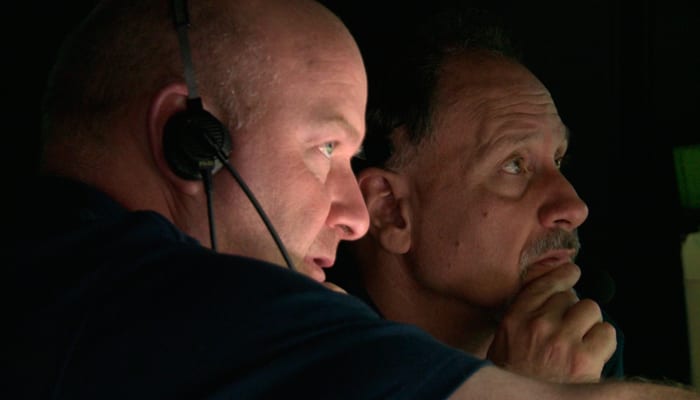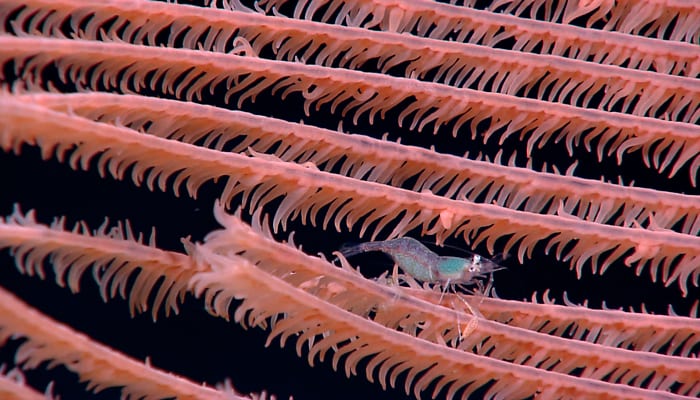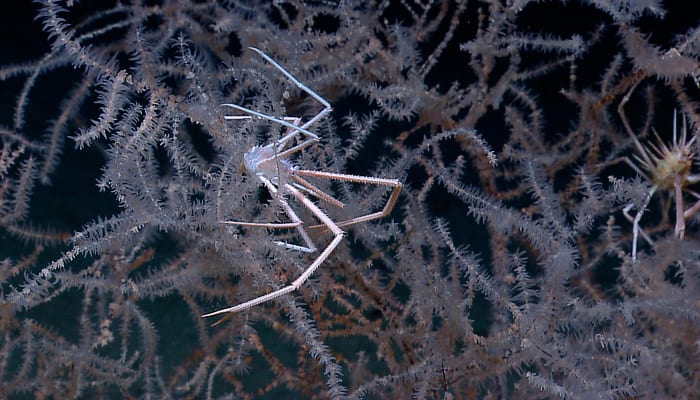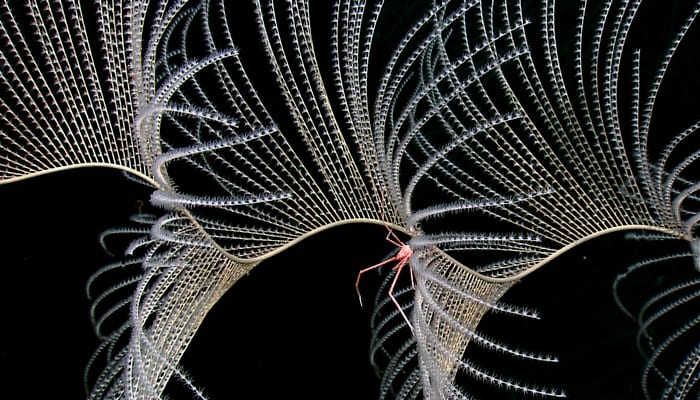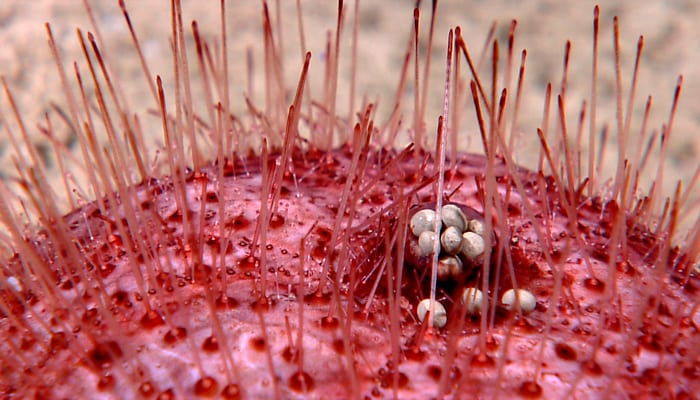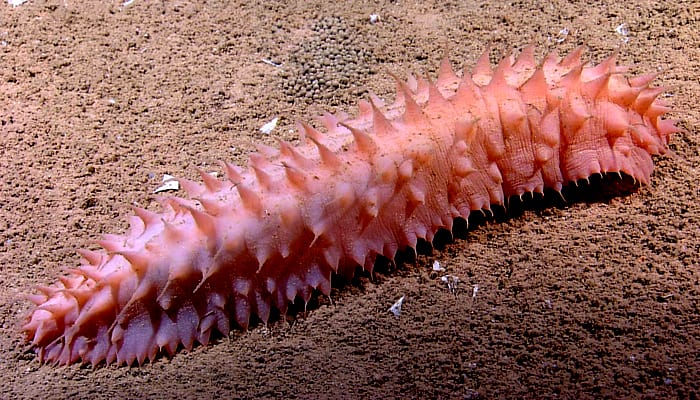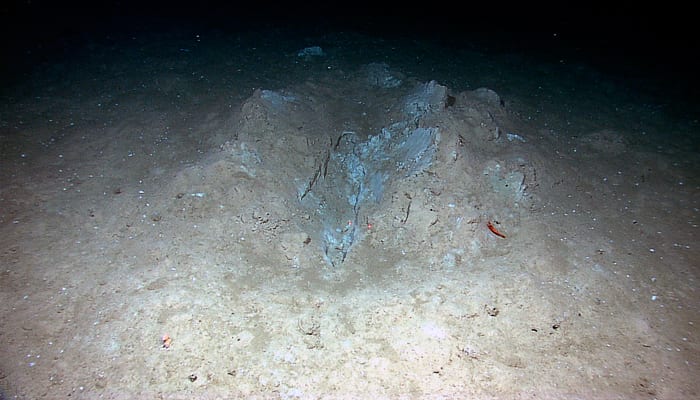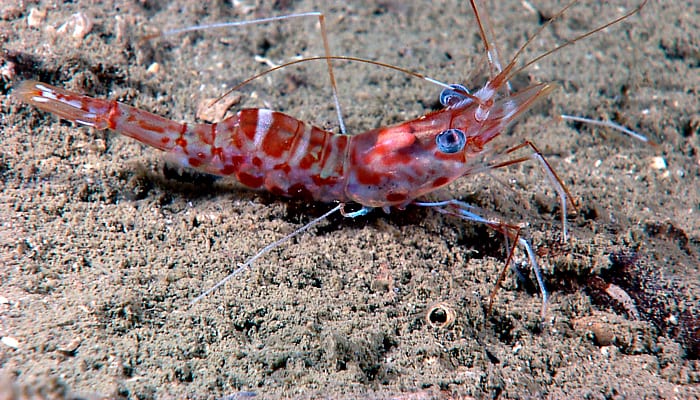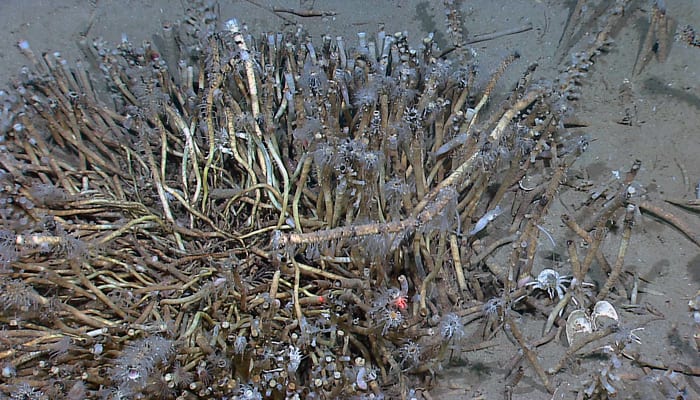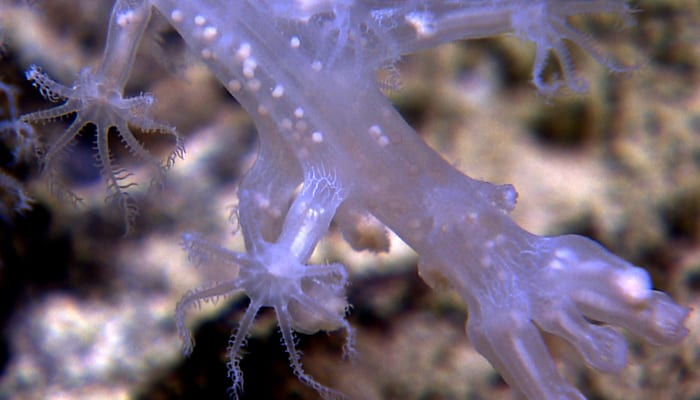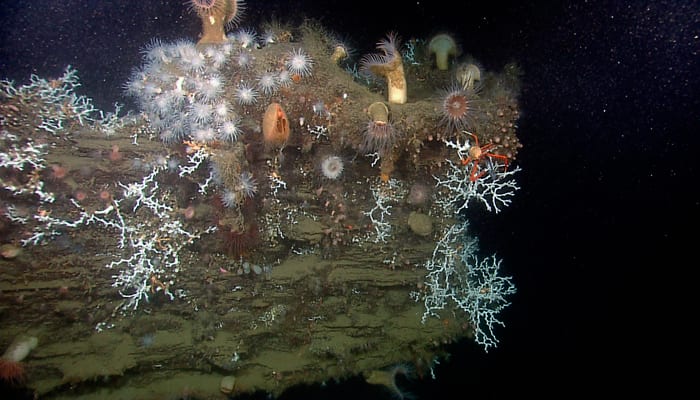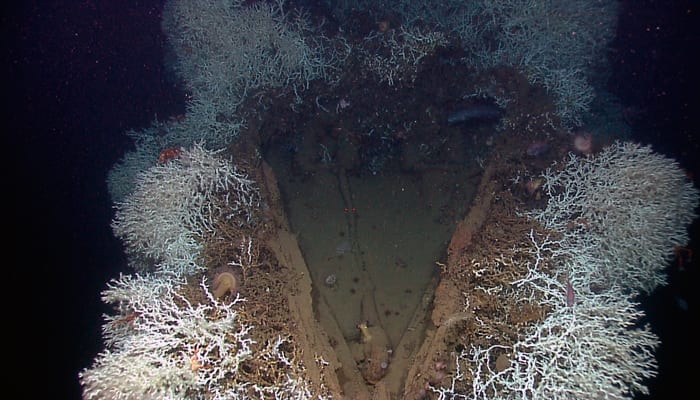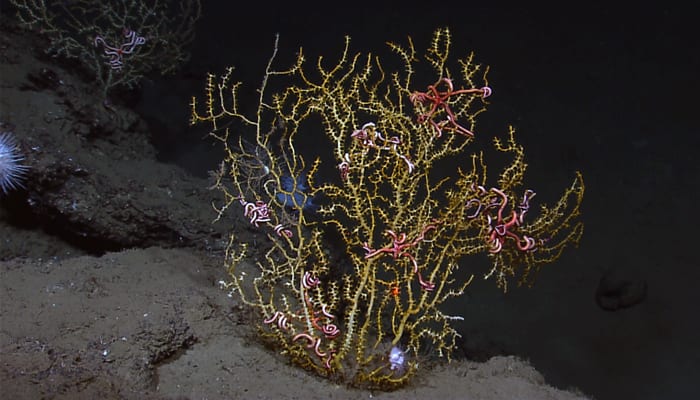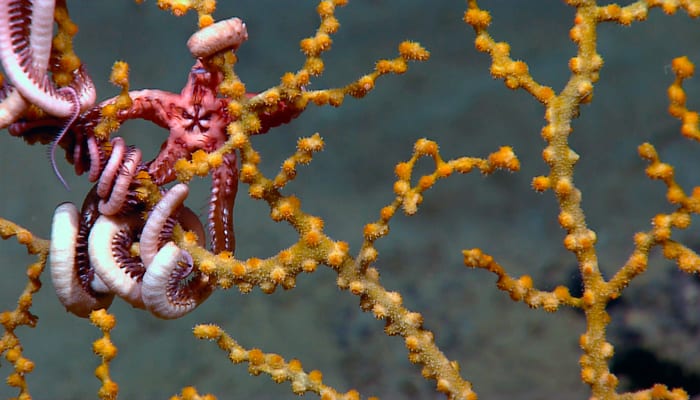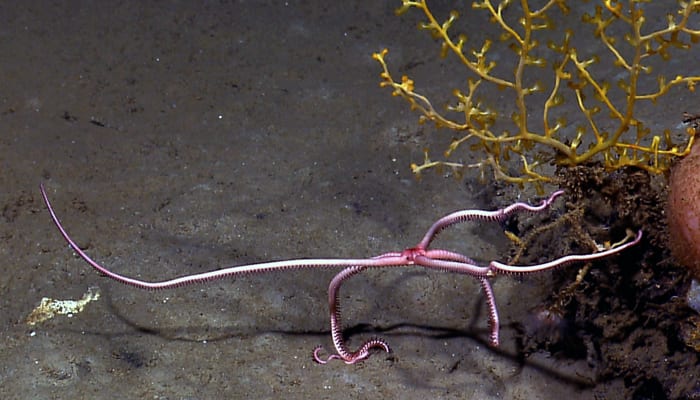- Okeanos Explorer, operated by the National Oceanographic and Atmospheric Administration (NOAA), is the nation’s only vessel devoted to exploration of the world’s oceans (rather than research). With this ship, its remotely operated vehicle (ROV) Little Hercules, and camera platform Seirios, scientists such as WHOI’s Tim Shank map portions of the seafloor and get a close-up look at features and creatures that have never been seen before. (Image courtesy of the NOAA Okeanos Explorer Program)
- Little Hercules at the bottom of the Gulf of Mexico in early spring, 2012. The shiny triangle on a bent stalk is a marker placed there by the Little Herc’s manipulator arm. Scientists leave such markers at places of interest for future visits. (Image courtesy of the NOAA Okeanos Explorer Program, Gulf of Mexico Expedition)
- A thin grey line shows the ship’s track from the start of the cruise in Tampa, Florida, to its end in Pascagoula, Mississippi. Along the way, researchers used remotely operated vehicles to explore regions along the West Florida Escarpment, an undersea cliff where the shallow continental shelf (lighter blue) drops to the deep seafloor thousands of feet below (darker blue). (Image courtesy of the NOAA Okeanos Explorer Program)
- Intensity reigns in the ship’s control room as WHOI biologist Tim Shank and ROV Team Coordinator Dave Lovalvo view images sent back from the seafloor by the video camera aboard the ROV Little Hercules. The headphones let Shank draw on the expertise of researchers around the world who were viewing the same images in real time via the ship’s “telepresence” system. (Image courtesy of Joe BiscottiNOAA)
- On the West Florida Escarpment, the researchers saw this shrimp on a feathery black coral (Bathypathes). Black corals are so named for the color of their skeleton, which in this photo is visible through the pink tissue. Other kinds of black coral have soft tissue of different colors. (Image courtesy of the NOAA Okeanos Explorer Program, Gulf of Mexico Expedition 2012)
- Another kind of black coral (Leiopathes) hosts a spidery crab. Another kind of crab is at right. This trio was found in just over 400 meters of water on the West Florida Escarpment. Crabs and shrimp hunt for small food items amid the coral’s arms and polyps. (Image courtesy of the NOAA Okeanos Explorer Program, Gulf of Mexico Expedition)
- Different habitat, different kind of coral, different kind of crab: At the edge of a steep cliff nearly 2,000 meters (1.25 miles) below the surface, a slender-legged chirostylid crab haunts the delicate spiral branches of an iridogorgid coral. (Image courtesy of the NOAA Okeanos Explorer Program, Gulf of Mexico Expedition)
- Eggs emerge from the gonopore of a sea urchin. Fertilization occurs in the seawater; the male releases sperm and then the female releases eggs. (Image courtesy of the NOAA Okeanos Explorer Program, Gulf of Mexico Expedition)
- A holothurian, or sea cucumber, makes its way across the seafloor as it scavenges for bits of detritus. Sea cucumbers make up a huge proportion of the animal biomass in the deep sea. The head (or front end) is at right. (Image courtesy of the NOAA Okeanos Explorer Program, Gulf of Mexico Expedition)
- The scientists think this gouge in the sediment was caused by the lower jaw of a whale as it foraged for squid or octopus resting on the seafloor. Similar gouges have been found in the Pacific and Atlantic Oceans and are sometimes used to help identify feeding grounds of beaked (toothed) whales. (Image courtesy of the NOAA Okeanos Explorer Program, Gulf of Mexico Expedition)
- A shrimp casts a wary, bulging eye on the camera. (Image courtesy of the NOAA Okeanos Explorer Program, Gulf of Mexico Expedition)
- The researchers investigated areas where sonar had shown bubbles rising through the water, which suggested methane or hydrogen sulfide was seeping out of the sediments. These areas are often home to vigorous communities of bacteria and the animals that depend on them. Here, a patch of tubeworms (Lamellibrachia) on such a site hosts anemones, Alvinocaris shrimp, and other deep-sea denizens. (Image courtesy of the NOAA Okeanos Explorer Program, Gulf of Mexico Expedition)
- Tiny embryos (white balls) were seen developing within the transparent tissue of an octocoral, so named because of the eight tentacles at the tip of each polyp. (Image courtesy of the NOAA Okeanos Explorer Program, Gulf of Mexico Expedition)
- The bow of a wooden ship that wrecked more than 100 years ago. Marine archaeologists on the expedition surveyed and evaluated three shipwreck sites to try to identify the ships, when they sank, and whether they possess enough cultural significance to be placed on the National Register of Historic Places. Biologists in the party also found a bonanza at the wrecks, which provided habitat for thriving communities of corals, anemones, and fish. (Image courtesy of the NOAA Okeanos Explorer Program, Gulf of Mexico Expedition)
- The bow of another old shipwreck, thickly crusted with Lophelia corals. A few anemones and fish can also be seen. Two of the three shipwreck sites had been found during seafloor sonar surveys by the oil and gas industry. (Image courtesy of the NOAA Okeanos Explorer Program, Gulf of Mexico Expedition)
- One coral may be associated with several other animals; this shrub-like gorgonian coral is host to about a dozen brittle stars (ophiuroids). (Image courtesy of the NOAA Okeanos Explorer Program, Gulf of Mexico Expedition)
- A brittle star’s arms cling to the branches of a coral while it forages. The brittle star’s mouth is the asterisk-shaped structure on the central part of the body. (Image courtesy of the NOAA Okeanos Explorer Program, Gulf of Mexico Expedition)
- A marine biologist’s dream come true—being at the right place at the right time to see a rare event and capture an image of it. This brittle star left its coral (upper right) after its arms touched a neighboring anemone. The brittle star used its arms to keep its basal disc, the central part of the body, off the muddy seafloor. (Image courtesy of the NOAA Okeanos Explorer Program, Gulf of Mexico Expedition)
SEARCH RELATED TOPICS: Benthic Life
Image and Visual Licensing
WHOI copyright digital assets (stills and video) on this website can be licensed for non-commercial use upon request and approval. Please submit your request via our Media Request Form.
For assistance or accessibility accommodations, call (508) 289-2647.
